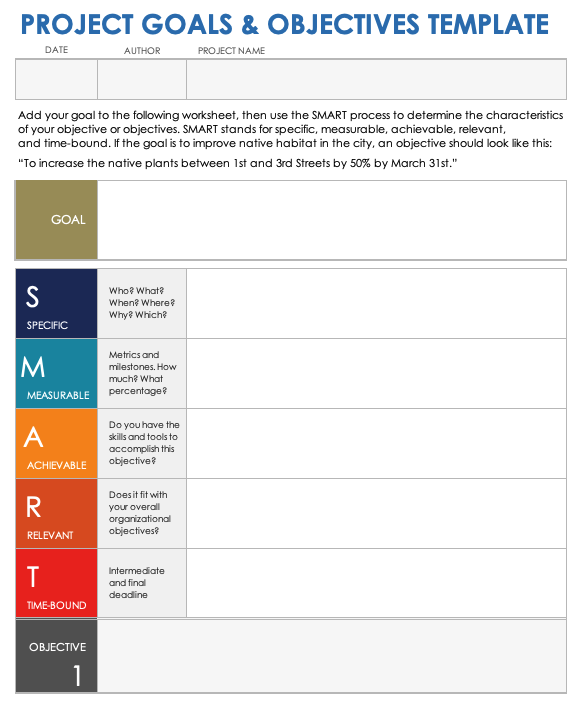What Are Project Goals?
A project goal is a statement that explains the expected outcome of a project. Project goals consist of objectives — measurable action items that support the goal’s success. They are essential because they promote improvement and help manage progress.
When leaders and stakeholders have a collective agreement to improve an area of their organization, they put a project goal into place. An organization's mission statement can inspire a goal, or it can be more specific, such as the need to improve an accounting workflow or maximize employee performance. Project goals are often the groundwork for other elements of a project, such as project descriptions.
When an organization sets a goal, managers establish objectives that include numbers and percentages so they can quantify and track them. Objectives help a project stay on course. Be sure to share all objectives and timelines with stakeholders and team members so that everyone is well-informed and aligned.
The Difference Between Project Goals and Project Objectives
A project goal explains what the project will accomplish. A project objective is a specific, measurable action item that supports the goal. Objectives form a checklist that keeps the project organized. Set a deadline for each objective so that the project stays on track to meet its target date.
An example of a project goal is to generate more sales revenue. The objectives to meet that goal are to increase the number of repeat purchases by 10 percent in the first quarter, and sales team members should spend two hours a week finding new leads.
Learn how to write functional project objectives to support goals.
You might have come across the term business objective while exploring project objectives. Business objectives are different from project objectives because they support a higher-level goal that impacts the organization as a whole. Business objectives support all business operations, whereas project objectives support a specific project. An example of a common business objective is launching a new product or service. This business objective impacts all areas of an organization from development to production to sales and accounting to training and more.
Why Project Goals Are Important
Project goals can help build momentum and motivate teams. Since they aim to improve an organization overall, they can help provide direction for growth.
Brett Harned is a project management consultant and coach with over 20 years of experience, and the author of Project Management for Humans: Helping People Get Things Done, says, “Goals are helpful because they help to focus (or refocus) teams and stakeholders when it comes to scope creep, indecision, off-track discussions in meetings, and so much more.”
Here is a list of why project goals are important:
- Aligns with Company Goals: When team members and stakeholders are working toward the same outcome, it creates unity and a sense of purpose within a company.
- Builds Momentum: When a team meets a project goal, it creates a sense of accomplishment and excitement, which is carried into the next project.
- Creates a Clear Focus: A project goal with a well-defined focus limits distractions and maximizes your company’s time and resources.
- Improves the Customer Experience: When a customer has a positive experience, it strengthens their loyalty, and they are more likely to refer your products or services to others.
- Motivates Team Members: Employees who work toward something that will benefit the organization often find that their positions bring value and are inspired to give their best performance.
- Promotes Accountability: The project goal workload is distributed among team members. Everyone has a clear understanding of their responsibilities.
How to Set Project Goals
Setting project goals starts with identifying something in your company that you need to change or improve. Discuss the goal with team members and stakeholders to get their take. Then determine resources and a budget to complete the goal.
- Identify a Collective Intent
Decide what in your organization needs improvement or change. Gather feedback from employees and internal and external customers to identify an area that needs attention. Your intent for the project goal should be focused. Engage leaders and stakeholders to help you clearly define what you want to accomplish with the goal. - Plan for Success
Anticipate what you need, throughout the entirety of the project, to avoid falling short. Secure the necessary resources prior to launching your project. Depending on the goal, look at how many employees you might need to work on it. If you think you’ll need equipment, software, or materials, be sure to secure them. Calculate how much these resources will cost, as you’ll need that data to prepare a budget. - Establish a Budget
Base the budget on your required resources and timeline. A project with a one-month timeline and three employees will have a very different budget than a project with a six-month timeline and more resources. If you need help with your budget, download a free budget template. - Communicate
Before the project takes off, share an overview and desired outcome with team members and stakeholders, even if they are not directly involved. Getting everyone on board with a project goal initially limits any confusion or misinformation. - Stay Organized
Schedule regular meetings with everyone involved in the project goal. This will build a routine for sharing progress, staying aligned, and addressing any challenges.
How to Write Project Goals
Writing project goals helps you organize the information you’ve collected. A project goal document includes a timeline, stakeholders, and objectives.
Follow these steps to document your project goal:
- Write Down the Project Goal
After speaking with team members and stakeholders, you should have a clear statement that defines your project goal. Start by writing down the goal. Determining the project goal is also the first step in a project design. - Determine a Timeline for the Project Goal
Decide your start date and end date for the project goal and add it to the document. Consider the scope of the project, resources, budget, and timelines for each objective. The start date should be the day you write the project goal, and the end date should be when the last objective is complete. - Establish Objectives for the Project Goal
Brainstorm milestones based on the project scope. Be detailed when writing project objectives. Each objective needs its own deadline leading up to the final goal. Set reminders to guarantee objectives are met when they’re due.
Using the SMART framework when writing objectives helps to keep each one specific, measurable, achievable, relevant, and time-bound.
Download a Project Goal Template
Download Project Goals and Objectives Template
Excel | Microsoft Word | Adobe PDF
Writing project goals doesn’t have to be a challenge. Using a free project goal template can help with formatting. State the goal at the top of the template and then add the objectives to meet the goal. Complete the SMART section for each objective to clearly define when the goal will be accomplished and how you will measure it for success.
Looking for a different focus? These goal-setting templates offer a variety of formats.
32 Examples of Project Goals
Examples of project goals are a helpful way to spur ideas for items you might need to improve in your company. This list of specific project goals are categorized by employee, customer, operational, and technology.
Examples of Employee-Focused Project Goals
- Increase employee engagement
- Improve communication with employees
- Increase employee safety
- Improve work-life balance for staff
- Strengthen team collaboration
- Facilitate quality training for new employees
- Decrease employee overtime
- Promote employee wellness
- Expand employee learning opportunities
- Reduce employee turnover
Customer-Focused Project Goal Examples
- Improve customer satisfaction
- Increase customer purchases
- Decrease customer service-related phone calls
- Improve the response time of customer requests and inquiries
- Increase social media engagement with customers
- Decrease customer wait times (on the phone or in person)
- Develop new marketing materials to attract new customers
Examples of Operational Project Goals
- Generate more sales revenue
- Improve a process or workflow
- Improve the speed of payments from claims and/or customers
- Reduce carbon footprint
- Provide on-time deliveries of products or services
- Cut operational costs
- Increase the engagement of stakeholders
- Decrease supply costs
- Increase sales leads
Technology Project Goal Examples
- Improve a system (for example, a billing system)
- Upgrade an office system, such as a phone system or content management system
- Improve the usability of the company website
- Roll out new software (for example, a scheduling app) to improve productivity
- Strengthen data security
- Improve systems for knowledge sharing
Project Goal-Setting Best Practices
When setting project goals, it’s important to set realistic deadlines. As a best practice, follow the project objectives to keep the goal on track.
Here are some additional best practices to follow when setting a project goal:
- Follow Project Objectives: The project objectives are how you’ll accomplish the goal. Don’t deviate from the plan.
- Keep Communication Lines Open: In addition to check-in meetings, let the team that is working on the objectives and the stakeholders who helped define the goal that you’re available for questions. Be sure to provide progress reports, as well.
- Keep Project Goals in the Conversation: It’s important to not let project goals fall to the wayside. Harned says, “Always keep project goals on the top of your mind and make sure everyone is aware of them from the start. Bringing them up when it’s relevant — during meetings, presentations, or even when deliberating options.”
- Meet Objective Deadlines: The objective deadline isn’t an arbitrary date. The due date is there to help you accomplish the goal. Setting up recurring meetings and consistent communication will ensure any roadblocks are addressed in a timely manner.
- Set Realistic Expectations for Deadlines: While it’s useful to get the input of leaders and stakeholders to help you determine the timelines of the objectives, it’s also essential to talk to those on the team who have to meet the deadlines for each objective.
5 Common Project-Goal-Setting Mistakes to Avoid
Setting project goals can go awry when you don’t include the right people in the process or set an accurate budget. Issues can also arise when you set an objective as a goal. Unattainable goals set you up for failure.
- Setting an Objective as a Goal
If your project goal is too specific, it becomes a short-term solution to a larger problem. For example, let’s say you set a goal to implement flexible work hours for employees. If you look closely, you’ll realize this should actually be an objective for the goal of improving work-life balance. The flexible working hours are a small piece of the bigger picture. Down the road, other work-life balance issues could arise, when they could have been addressed with the right goal. Margaret Love, PMP, and Project Management Consultant with 40 years of experience, highlights what can go wrong, “I've seen projects where the goals and objectives were too detailed — information that should have been explored in other documents was crammed into goals and objectives without thorough analysis. In my opinion, the goals and objectives would be at a high enough level that senior management can easily see whether or not they have been met.” - Setting an Unattainable Goal
Unattainable goals can discourage team members. They might feel defeated and lose momentum. They can also create a lack of trust and motivation in future goal-setting initiatives.
For example, you set a goal to roll out a new phone system for your customer service team to go live in two days. Although the phone system will be beneficial, the short time frame will likely cause stress and frustration. The team needs time to learn, understand, and practice the system. Always consider your project scope and timeline when setting a goal. - Not Including the Right People
Leaving out key players is detrimental to the success of your goal. If you set a project goal to decrease supply costs, the stakeholders and leaders who work with supplies need to be involved in the project. - Not Scheduling Recurring Meetings
Be sure to schedule meetings across the entire timeline of your project to keep your team well-informed. Even short meetings will help ensure that you can address any roadblocks quickly.
Patti Armanini has worked in quality for over 40 years and advises, “Not performing regular reviews can cause the goal to miss target at the end of the project timeframe.” - Not Staying Within Your Budget
Spending beyond your project budget can rob future projects of their allocations. When the finances don’t go as planned, it can cause stress and affect morale.
Use Smartsheet to Track the Progress of Project Goals
Empower your people to go above and beyond with a flexible platform designed to match the needs of your team — and adapt as those needs change. The Smartsheet platform makes it easy to plan, capture, manage, and report on work from anywhere, helping your team be more effective and get more done. Report on key metrics and get real-time visibility into work as it happens with roll-up reports, dashboards, and automated workflows built to keep your team connected and informed. When teams have clarity into the work getting done, there’s no telling how much more they can accomplish in the same amount of time. Try Smartsheet for free, today.


